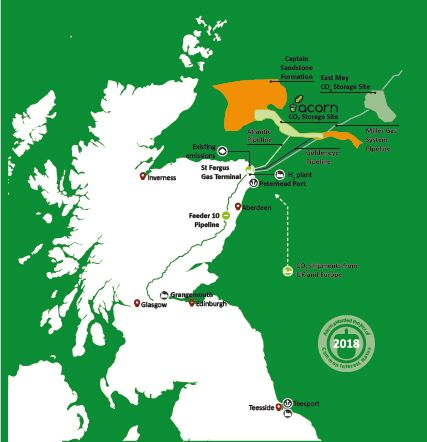A rigorous approach to choosing geological CO2 storage sites, developed to support early-stage concept selection for a live carbon capture and storage (CCS) project in north-east Scotland, is explained in a new paper aimed at sharing the approach with the wider community of CCS developers.

ACT Acorn infographic on storage site research
Geoscientists engaged in selecting an additional storage site for the Acorn Project, which could be storing CO2 from Scotland’s industrial clusters by the middle of this decade, assessed different aspects of potential storage sites, including rock characteristics, hydrocarbon history, economics and safety requirements. The result of these exhaustive analyses is what the researchers term a “criteria-driven approach” to choosing the East Mey storage site for the Acorn Project and a methodology that can be applied to CCS projects in other countries.
CCS involves capturing CO2 from large-scale emitters and then transporting the liquified gas for storage in suitable rocks deep below ground. Storage sites require a particular set of characteristics to ensure the safe and permanent storage of the greenhouse gas.
The researchers from Heriot-Watt University, Pale Blue Dot Energy (PBDE), University of Aberdeen, University of Edinburgh and University of Liverpool filtered, compared and ranked a shortlist of well-understood North Sea geological sites. Due diligence assessments, which included new interpretation of geological data, was carried out to produce detailed pictures of CO2 storage properties, resource quantities and suitability for each site. Finally, the results were shared with independent stakeholders to gain feedback on the criteria used in the site selection process.
Dr Juan Alcalde, Geosciences Barcelona (GEO3BCN-CSIC), lead author, then based at the University of Aberdeen, said:
"Our approach included the filtering of 113 potential sites down to six from the UK CO2Stored database, using general and project-specific criteria. This involved different stages of analysis and deliberation, which helped us fine-tune our approach. We filtered out the less suitable sites early on and could then focus on a more comprehensive comparison and ranking of the 15 most suitable sites. Our methodology should prove invaluable for developers of the next wave of CCS projects."
Alan James, of Storegga (formerly PBDE), lead developers of the Acorn Project, said:
"This work made a really valuable contribution to the development of the Acorn Project, which is designed to enable a critically important, scalable, CO2 transport and storage solution in the Central North Sea. This secondary storage site will hopefully serve as a growth and back-up option for the Acorn Project, and has to satisfy pivotal project requirements, such as low cost and high storage potential."
The research presented by this new paper was undertaken as part of the ACT Acorn project funded through the Accelerating CCS technologies (ACT) co-fund of ERA-NET under the European Union’s Horizon 2020 programme. The ACT Acorn consortium was led by Pale Blue Dot Energy and included the Bellona Foundation, Heriot-Watt University, Radboud University, Scottish Carbon Capture & Storage, University of Aberdeen, University of Edinburgh and University of Liverpool.
KeyFacts Energy Industry Directory: University of Aberdeen l University of Liverpool
 KEYFACT Energy
KEYFACT Energy